The next-generation iPhone is expected to be called the iPhone 7. 2015 marked an "S" iPhone upgrade year that introduced new features such as an improved camera and a better processor, but 2016 will bring an even-year upgrade that will include an all-new iPhone design in addition to new features.
Apple will continue releasing two versions of each iPhone, so we can expect to see an iPhone 7 and an iPhone 7 Plus in 2016. Apple is said to be planning to stick to the 4.7- and 5.5-inch screen sizes it first introduced with the iPhone 6 and 6 Plus.
Apple is said to be working on finalizing the iPhone 7's body so we don't know exactly what it will look like, but multiple rumors suggest it continues to use a design similar to the design of the iPhone 6s. It is said to have the same general shape, but it is thinner and may have a camera that protrudes less (though rumors currently disagree on this point). Antenna bands across the back of the device have been removed, but are expected to remain at the top, bottom, and sides of the iPhone.

Apple is rumored to be aiming to make the iPhone 7 nearly as thin as the 6.1mm iPod touch, mainly through the removal of the 3.5mm headphone jack and the implementation of a thinner Lightning port. Eliminating the headphone jack will give Apple more internal space for other components, and Apple will also keep the device slim with the continued use of in-cell panels and TFT-LCD display technology. Apple may replace the headphone jack on the iPhone 7 with a second speaker for stereo audio.
With no headphone jack, wired headphones will connect to the iPhone 7 using its Lightning port and Bluetooth headphones will connect wirelessly. Apple is rumored to be working on Lightning-equipped EarPods to sell alongside the iPhone 7.
An image of a device said to be the iPhone 7 Plus has surfaced depicting a Smart Connector on the back of the shell, suggesting that is another potential feature, but it is not yet clear what it would be used for.
Internal specs for the iPhone 7 aren't yet known, but we can speculate Apple will continue on its path of introducing more powerful, efficient devices that grow thinner with each design iteration. The iPhone 7 and iPhone 7 Plus are expected to include next-generation A10 processors manufactured by TSMC.
There are rumored to be some distinguishing features between the iPhone 7 and the larger-screened iPhone 7 Plus. The iPhone 7 may ship with 2GB RAM, while the iPhone 7 Plus could include 3GB RAM, and there is said to be a different camera system that uses two cameras instead of one.
According to rumors, Apple may be planning to introduce two versions of the iPhone 7 Plus -- one with a single lens like the iPhone 7 and a second with a dual-lens camera system that offers DSLR-like image quality with 2-3x optical zoom and improved performance in low light conditions.
Part Leaks
A photo of a device said to be the iPhone 7 Plus surfaced on a Chinese website
in March. It features a design that's similar in shape to the iPhone
6s, but without rear antenna bands. It has a protruding, pill-shaped
camera enclosure that includes two cameras inside, as is rumored for the
larger-screened device, along with a round flash.
It also depicts a Smart Connector on the back of the iPhone, which is an unusual inclusion. There's a Smart Connector on the iPad Pro for connecting accessories, but it is unclear how a similar feature would be used on iPhones.

It is not known if this is a genuine iPhone 7 Plus prototype, a dummy based on iPhone 7 Plus specifications, or a completely fake device, but it's possible this is our first look at Apple's new iPhone design. As September nears, additional rumors will confirm whether or not this is a genuine image.
Images depicting what could potentially be the dual-lens camera component for the iPhone 7 Plus surfaced from multiple sources in the early months of 2016. The part has an "821" number on it, which has been associated with Apple in the past, suggesting it could be a legitimate component.
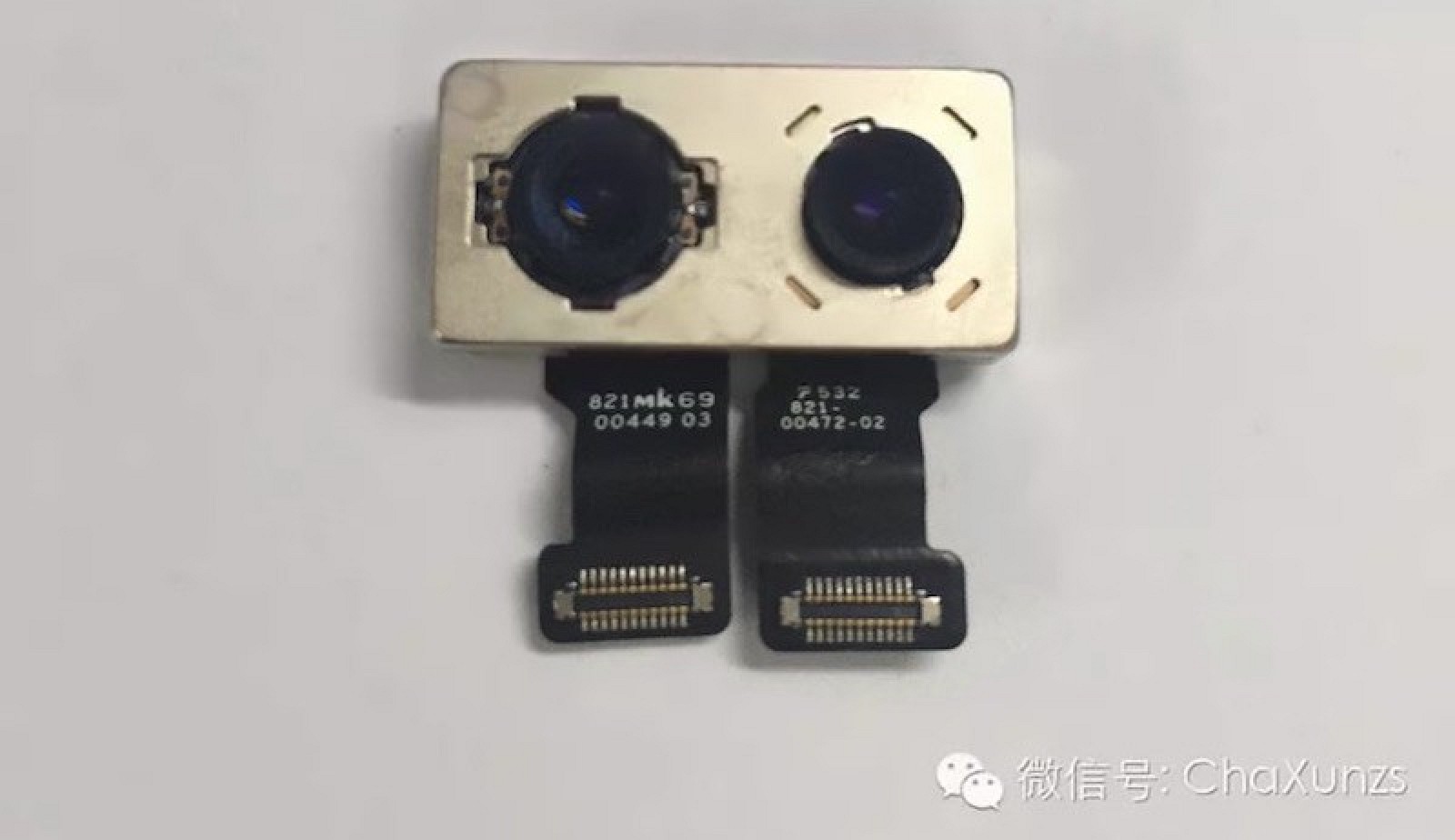
An image of the battery said to be for the iPhone 7 has surfaced, listing a capacity of 7.04 watt-hours. That's slightly larger than the equivalent battery capacity listed for the iPhone 6s (6.61 watt-hours) and almost identical to the iPhone 6 (7.01 watt-hours). Voltage is not visible on the alleged iPhone 7 battery, so the exact charge capacity is not yet available, but should be similar to the iPhone 6 battery.
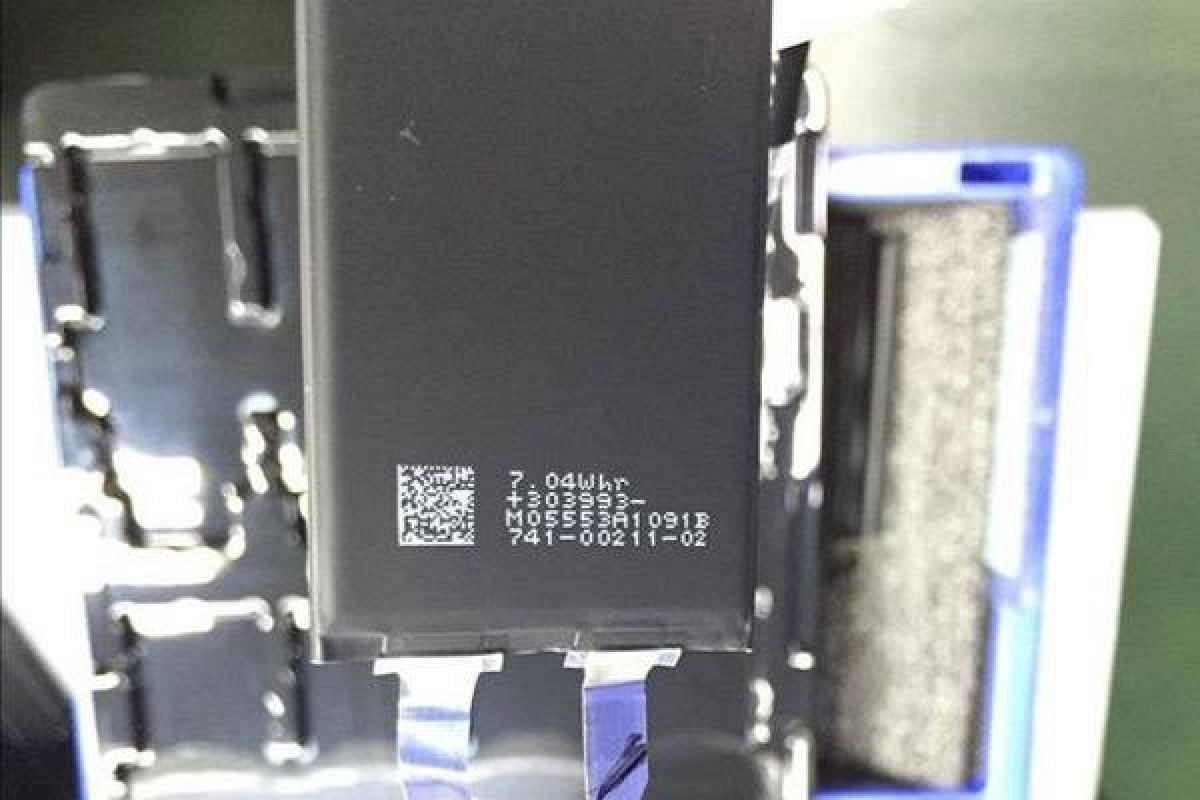
We've seen a backlight assembly said to be destined for the iPhone 7, which surfaced in January of 2016. We can't really glean any information about the iPhone 7 from the backlight component, but it is similar in design to the iPhone 6s and 6s Plus backlight assembly with the exception of relocated LCD flex cables and 3D Touch chip. Though the backlight assembly doesn't give us any information about the iPhone 7, it suggests that components are now in production and additional part leaks will follow.
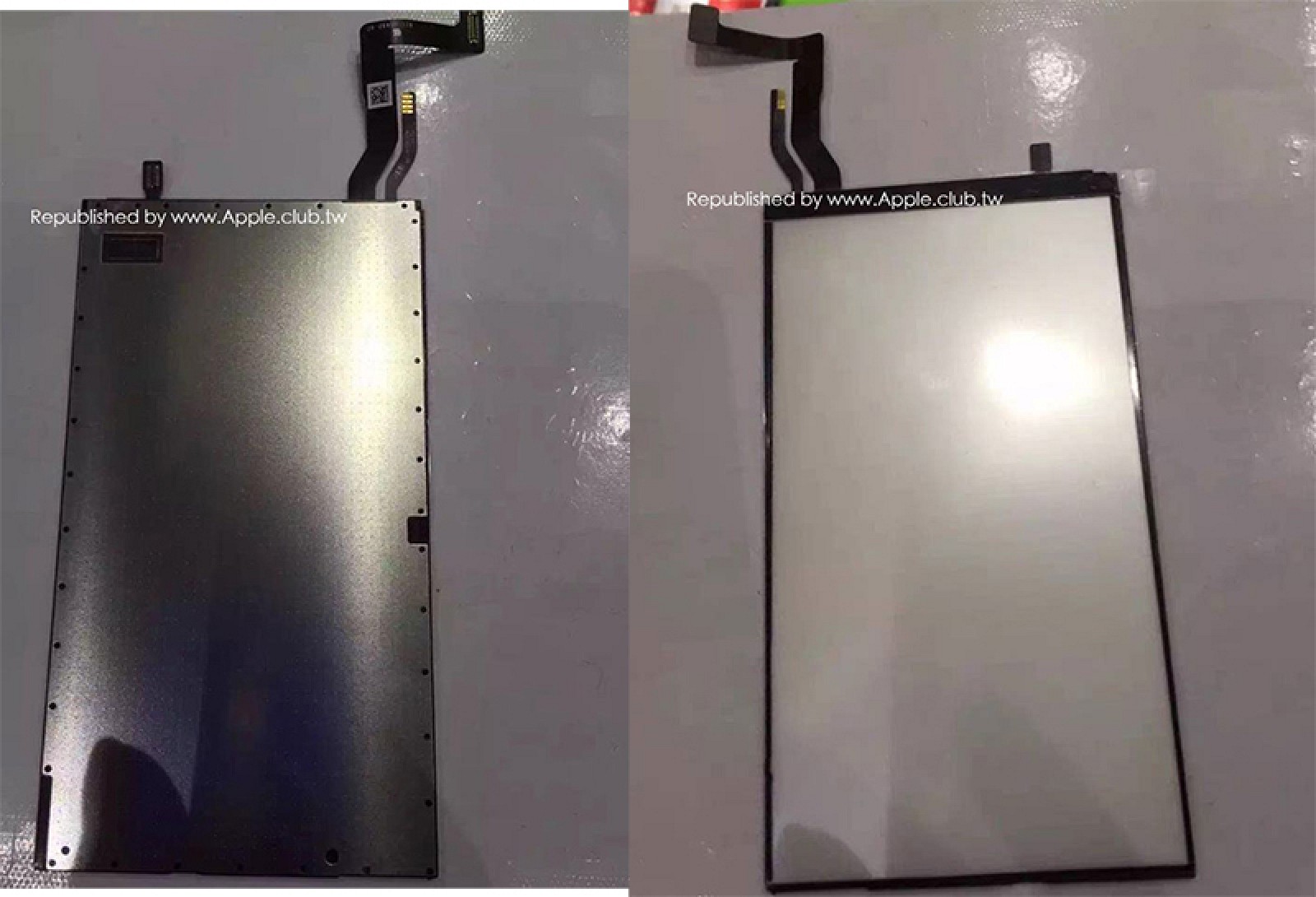
It also depicts a Smart Connector on the back of the iPhone, which is an unusual inclusion. There's a Smart Connector on the iPad Pro for connecting accessories, but it is unclear how a similar feature would be used on iPhones.

It is not known if this is a genuine iPhone 7 Plus prototype, a dummy based on iPhone 7 Plus specifications, or a completely fake device, but it's possible this is our first look at Apple's new iPhone design. As September nears, additional rumors will confirm whether or not this is a genuine image.
Images depicting what could potentially be the dual-lens camera component for the iPhone 7 Plus surfaced from multiple sources in the early months of 2016. The part has an "821" number on it, which has been associated with Apple in the past, suggesting it could be a legitimate component.

An image of the battery said to be for the iPhone 7 has surfaced, listing a capacity of 7.04 watt-hours. That's slightly larger than the equivalent battery capacity listed for the iPhone 6s (6.61 watt-hours) and almost identical to the iPhone 6 (7.01 watt-hours). Voltage is not visible on the alleged iPhone 7 battery, so the exact charge capacity is not yet available, but should be similar to the iPhone 6 battery.

We've seen a backlight assembly said to be destined for the iPhone 7, which surfaced in January of 2016. We can't really glean any information about the iPhone 7 from the backlight component, but it is similar in design to the iPhone 6s and 6s Plus backlight assembly with the exception of relocated LCD flex cables and 3D Touch chip. Though the backlight assembly doesn't give us any information about the iPhone 7, it suggests that components are now in production and additional part leaks will follow.

Case Leaks and Renderings
An image allegedly sourced from Apple manufacturer Catcher Technology
depicts the body of the iPhone 7, showing a design that's similar to
the iPhone 6s. In line with other rumors, the image shows antenna bands
that are limited to the sides and top of the device, no longer spanning
across the back.
There also appears to be a larger hole for the camera, which may protrude slightly. Some iPhone 7 rumors have suggested the camera will not protrude at all. It appears that if there is a protrusion, it will be less pronounced than the camera bump on the iPhone 6s.
Nowhereelse.fr's Steve Hemmerstoffer created a rendering of the camera design based on the drawing, which can be seen below. While the iPhone 7 is said to have a single camera as shown, the iPhone 7 Plus is rumored to have a dual-camera design.
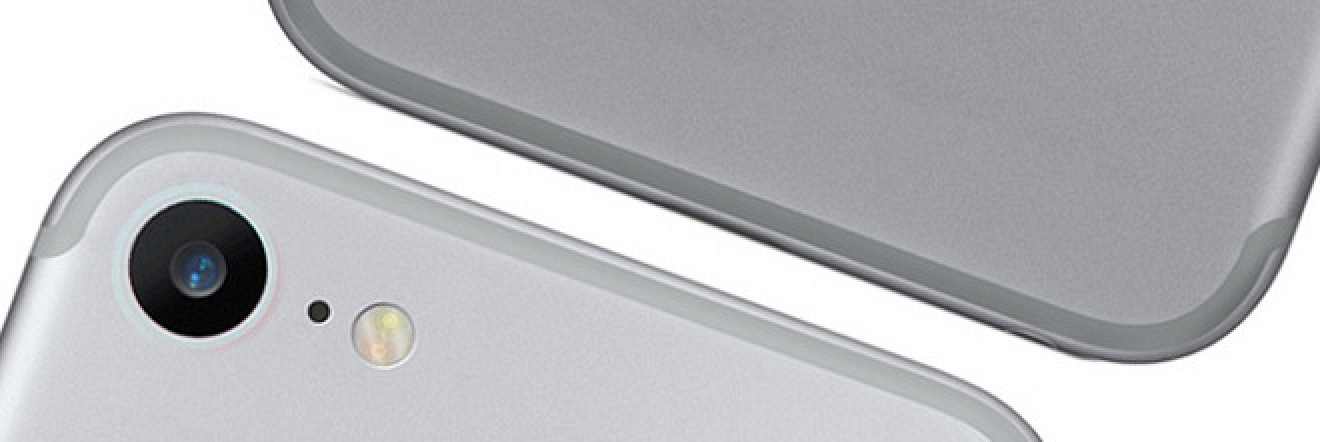
Feld & Volk, a company that creates luxury enclosures for the iPhone, has used a leaked image of what is said to be the iPhone 7 Plus (depicted in the section above) to create a set of detailed renderings that give a clearer picture of what the larger-screened device might look like.
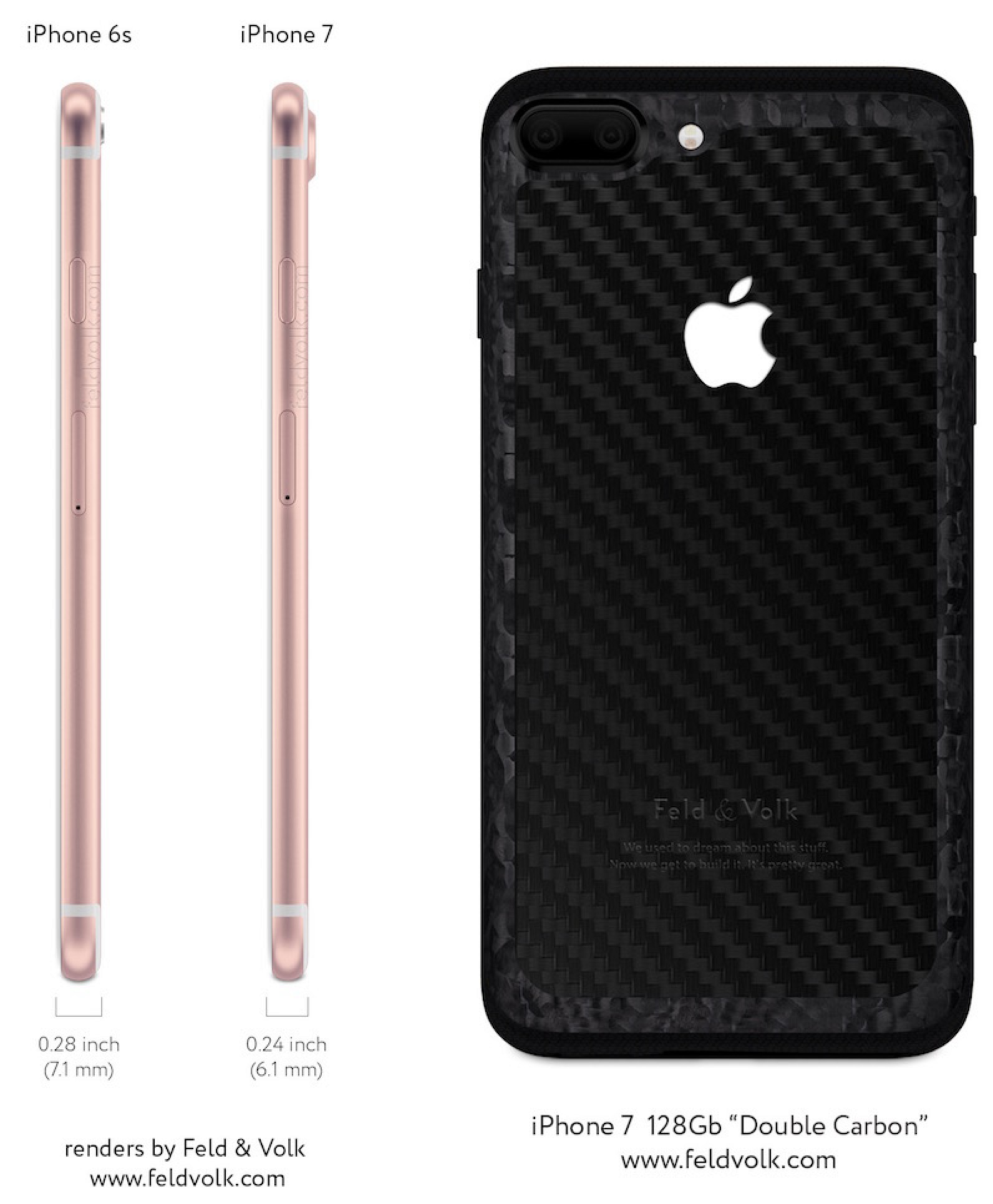 The renderings depict a phone that is a good deal thinner than the
iPhone 6s, which is in line with rumors suggesting the iPhone 7 and 7
Plus will be up to 1mm thinner. It includes a dual camera with a
protruding enclosure and a Smart Connector, the purpose of which is not
known.
The renderings depict a phone that is a good deal thinner than the
iPhone 6s, which is in line with rumors suggesting the iPhone 7 and 7
Plus will be up to 1mm thinner. It includes a dual camera with a
protruding enclosure and a Smart Connector, the purpose of which is not
known.
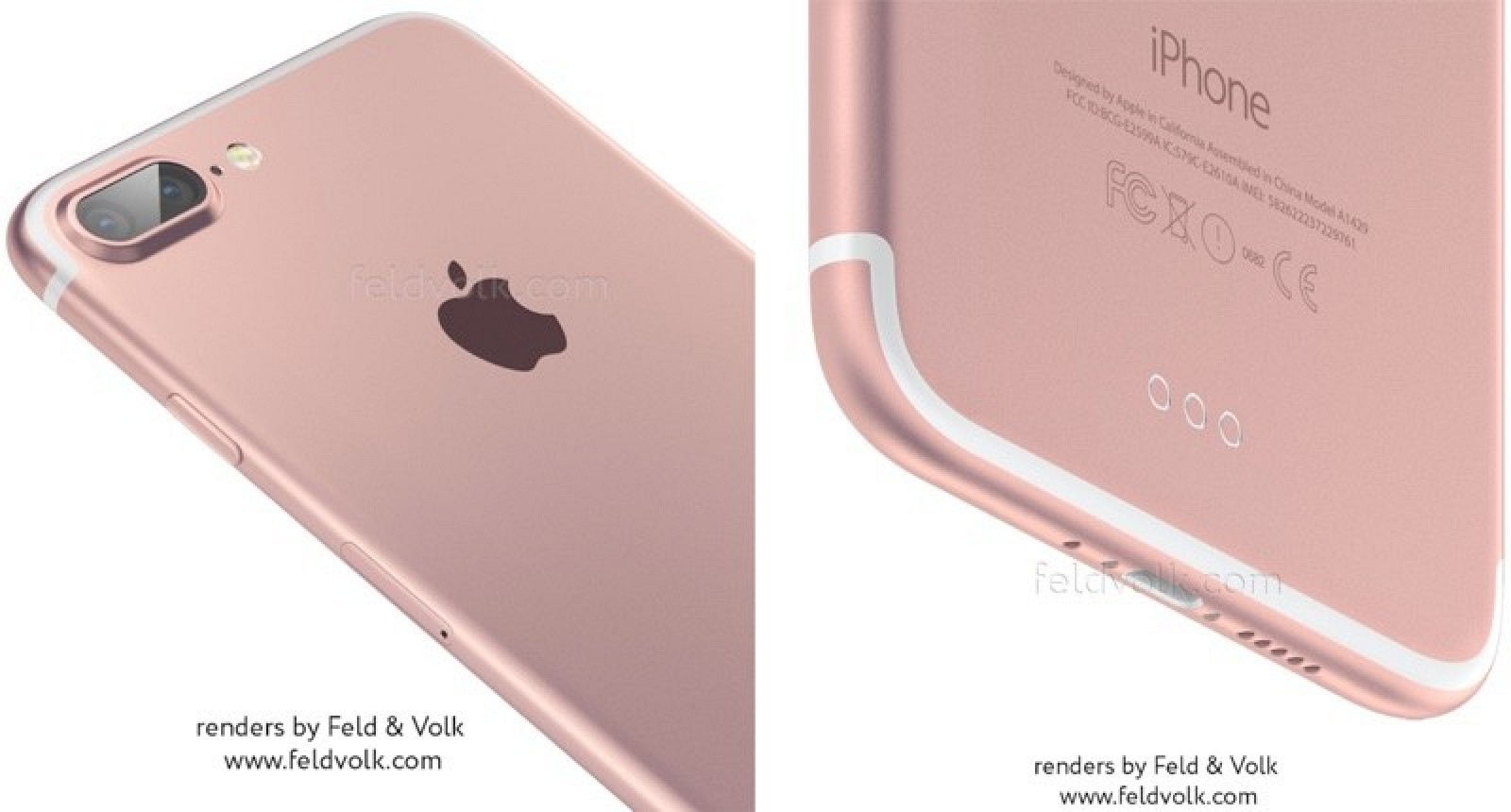
Overall, the device, while thinner, looks much like the iPhone 6s. Design changes include no rear antenna bands, but there continue to be bands at the bottom and the sides. Volume buttons, mute switch, and power button remain unchanged. It is not clear if this is the actual design of the iPhone, but it is a possibility and is in line with rumors.
The first alleged case for the iPhone 7 surfaced in March, with the overall design appearing to be similar to the iPhone 6s. It features the same pill-shaped volume buttons and side-located power buttons, but it has cutouts for two speakers, in line with a rumor suggesting the iPhone 7 will have stereo speakers.
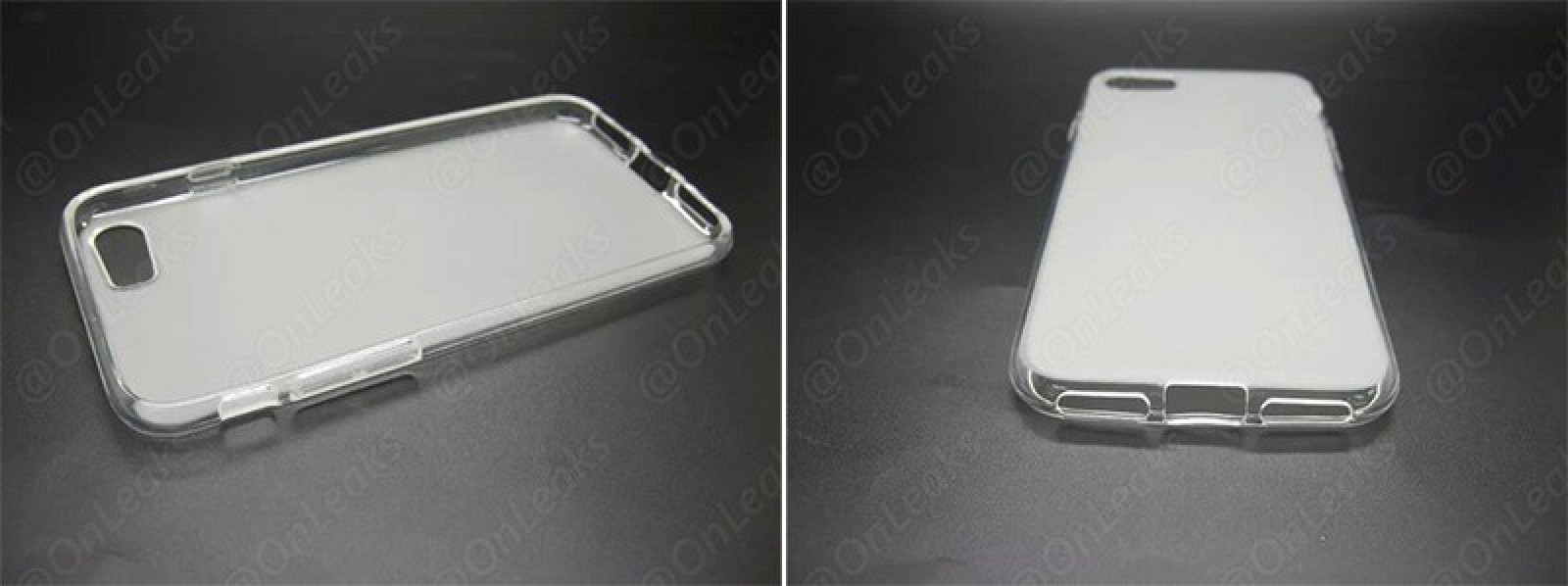
The two speaker cutouts replace the cutout for a headphone jack, which is said to be eliminated in the iPhone 7 in favor of an all-in-one Lightning port.
The iPhone 7 case was compared to an iPhone 6s on YouTube, and while the older device fit into the iPhone 7 case, there were some differences. The iPhone 7 case appears to have a larger opening for the camera, which could be designed to accommodate a larger single-lens camera on the iPhone 7.
Because the iPhone 6s fit almost perfectly into the iPhone 7 case, it's possible that it won't be quite as thin as rumored. Current rumors suggest the iPhone 7 could be as thin as 6.1mm.
Early cases for new devices are often based on schematics obtained from factory workers and other inside sources and can give a solid picture of upcoming iPhone designs, but they are not accurate 100 percent of the time.
There also appears to be a larger hole for the camera, which may protrude slightly. Some iPhone 7 rumors have suggested the camera will not protrude at all. It appears that if there is a protrusion, it will be less pronounced than the camera bump on the iPhone 6s.
Nowhereelse.fr's Steve Hemmerstoffer created a rendering of the camera design based on the drawing, which can be seen below. While the iPhone 7 is said to have a single camera as shown, the iPhone 7 Plus is rumored to have a dual-camera design.

Feld & Volk, a company that creates luxury enclosures for the iPhone, has used a leaked image of what is said to be the iPhone 7 Plus (depicted in the section above) to create a set of detailed renderings that give a clearer picture of what the larger-screened device might look like.
 The renderings depict a phone that is a good deal thinner than the
iPhone 6s, which is in line with rumors suggesting the iPhone 7 and 7
Plus will be up to 1mm thinner. It includes a dual camera with a
protruding enclosure and a Smart Connector, the purpose of which is not
known.
The renderings depict a phone that is a good deal thinner than the
iPhone 6s, which is in line with rumors suggesting the iPhone 7 and 7
Plus will be up to 1mm thinner. It includes a dual camera with a
protruding enclosure and a Smart Connector, the purpose of which is not
known.
Overall, the device, while thinner, looks much like the iPhone 6s. Design changes include no rear antenna bands, but there continue to be bands at the bottom and the sides. Volume buttons, mute switch, and power button remain unchanged. It is not clear if this is the actual design of the iPhone, but it is a possibility and is in line with rumors.
The first alleged case for the iPhone 7 surfaced in March, with the overall design appearing to be similar to the iPhone 6s. It features the same pill-shaped volume buttons and side-located power buttons, but it has cutouts for two speakers, in line with a rumor suggesting the iPhone 7 will have stereo speakers.

The two speaker cutouts replace the cutout for a headphone jack, which is said to be eliminated in the iPhone 7 in favor of an all-in-one Lightning port.
The iPhone 7 case was compared to an iPhone 6s on YouTube, and while the older device fit into the iPhone 7 case, there were some differences. The iPhone 7 case appears to have a larger opening for the camera, which could be designed to accommodate a larger single-lens camera on the iPhone 7.
Because the iPhone 6s fit almost perfectly into the iPhone 7 case, it's possible that it won't be quite as thin as rumored. Current rumors suggest the iPhone 7 could be as thin as 6.1mm.
Early cases for new devices are often based on schematics obtained from factory workers and other inside sources and can give a solid picture of upcoming iPhone designs, but they are not accurate 100 percent of the time.
Design
The iPhone 7 is expected to be thinner than the iPhone 6s, with Apple using the elimination of the headphone jack, advances in chip packing technology, and a slimmer Lightning port
to cut down on the thickness of the device. Rumors suggest the iPhone 7
will be between 6.0mm and 6.5mm. Apple's current iPod touch, one of its
thinnest devices, measures in at 6.1mm, compared to 7.1mm for the
iPhone 6s and 7.3mm for the iPhone 6s Plus.
Information obtained by MacRumors and confirmed by additional reports indicates the iPhone 7's design will be somewhat similar to the iPhone 6s, adopting the same general design language.
Apple may be planning to change the design of the antenna bands on the device, doing away with the thick white antenna bands that are located across the back of the Phone 6s rear shell. The bands located at the top, bottom, and sides of the device are rumored to remain on the iPhone 7, but the rear bands are eliminated for a cleaner look. As for the thinner Lightning port, while Apple plans to slim it down, it will continue to be compatible with existing the Lightning connector and Lightning cables.
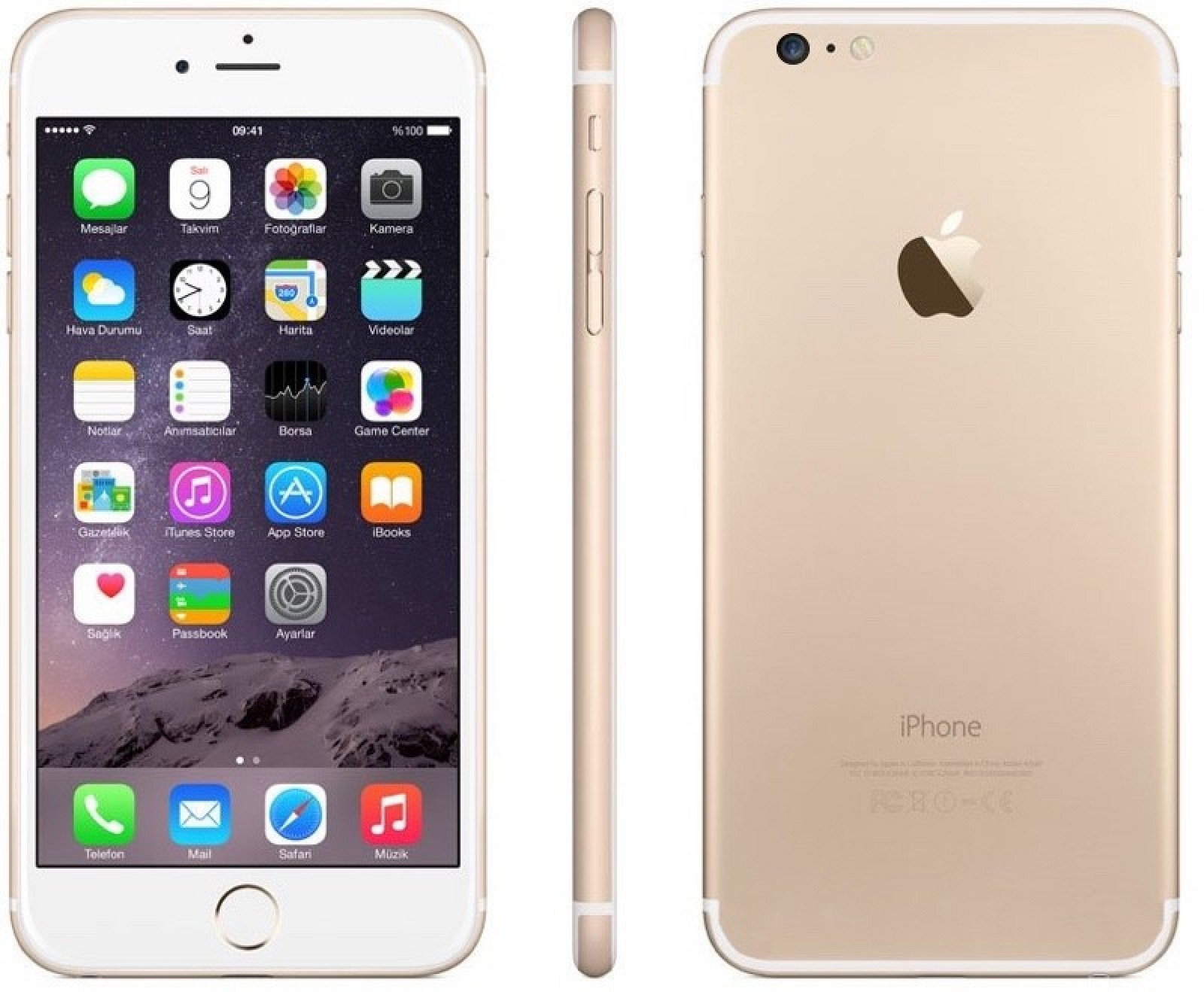
A
mockup of what the iPhone 7 may look like. It is said to have a design
similar to the iPhone 6s, with a slightly thinner body and no antenna
bands across the middle of device's rear shell.
Rumors on the rear camera have varied. Some rumors point towards a camera that protrudes less or not at all, while an image of an alleged iPhone 7 Plus features a camera that continues to protrude.
Early rumors about the iPhone 7's design suggested the device could have a strengthened, water resistant frame that ditches Apple's traditional aluminum casing for "new compound materials, but a report from Mac Otakara says that is not the case. The iPhone 7 will use the same aluminum that's used in the iPhone 6s and it will be no more water resistant.
Apple is planning to implement improved electromagnetic interference (EMI) shielding techniques in the iPhone 7, with the goal of individually shielding most of the major chips in the device. EMI shields are used in iPhones and all other electronic devices to prevent wireless interference between different products.
Improved EMI shielding will perhaps allow Apple to place the various chips in the iPhone 7 closer together, allowing it to shrink down the device or leave room for new components or a larger battery. This could be one of the ways the company will find extra space to make the iPhone 7 thinner than the iPhone 6s.
Apple is said to be planning to use a new fan-out packaging technology for the antenna switching module and radio frequency chip in the iPhone 7, which is a feature that allows the iPhone to switch between LTE and other antennas like GSM and CDMA. Fan-out packaging technology allows for a greater number of I/O terminals while cutting down on chip size.
Using this packaging method, along with single-chip EMI shields, Apple will be able to fit more components into a single package while minimizing signal loss and also cutting down on the potential for interference in wireless communication.
Apple is rumored to be working on AMOLED displays for future iPhones, but the technology will not be ready for the iPhone 7. The iPhone 7 will continue to use the same TFT-LCD display technology used in the iPhone 6s.
Information obtained by MacRumors and confirmed by additional reports indicates the iPhone 7's design will be somewhat similar to the iPhone 6s, adopting the same general design language.
Apple may be planning to change the design of the antenna bands on the device, doing away with the thick white antenna bands that are located across the back of the Phone 6s rear shell. The bands located at the top, bottom, and sides of the device are rumored to remain on the iPhone 7, but the rear bands are eliminated for a cleaner look. As for the thinner Lightning port, while Apple plans to slim it down, it will continue to be compatible with existing the Lightning connector and Lightning cables.

Rumors on the rear camera have varied. Some rumors point towards a camera that protrudes less or not at all, while an image of an alleged iPhone 7 Plus features a camera that continues to protrude.
Early rumors about the iPhone 7's design suggested the device could have a strengthened, water resistant frame that ditches Apple's traditional aluminum casing for "new compound materials, but a report from Mac Otakara says that is not the case. The iPhone 7 will use the same aluminum that's used in the iPhone 6s and it will be no more water resistant.
Apple is planning to implement improved electromagnetic interference (EMI) shielding techniques in the iPhone 7, with the goal of individually shielding most of the major chips in the device. EMI shields are used in iPhones and all other electronic devices to prevent wireless interference between different products.
Improved EMI shielding will perhaps allow Apple to place the various chips in the iPhone 7 closer together, allowing it to shrink down the device or leave room for new components or a larger battery. This could be one of the ways the company will find extra space to make the iPhone 7 thinner than the iPhone 6s.
Apple is said to be planning to use a new fan-out packaging technology for the antenna switching module and radio frequency chip in the iPhone 7, which is a feature that allows the iPhone to switch between LTE and other antennas like GSM and CDMA. Fan-out packaging technology allows for a greater number of I/O terminals while cutting down on chip size.
Using this packaging method, along with single-chip EMI shields, Apple will be able to fit more components into a single package while minimizing signal loss and also cutting down on the potential for interference in wireless communication.
Apple is rumored to be working on AMOLED displays for future iPhones, but the technology will not be ready for the iPhone 7. The iPhone 7 will continue to use the same TFT-LCD display technology used in the iPhone 6s.
No Headphone Jack
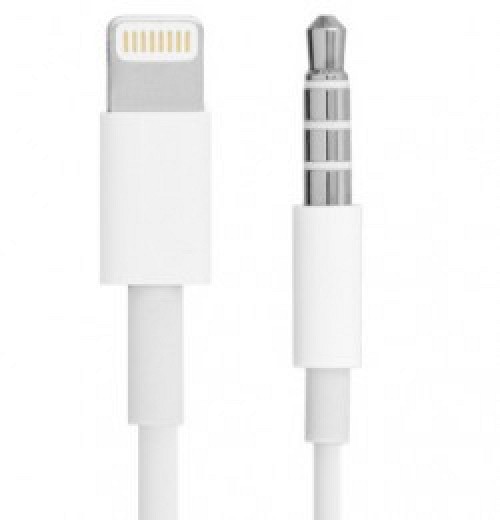 Apple may be able to decrease the thickness of the iPhone 7 by eliminating the headphone jack and instead adopting an all-in-one Lightning port that will support both charging and music playback with Lightning-equipped headphones.
Apple may be able to decrease the thickness of the iPhone 7 by eliminating the headphone jack and instead adopting an all-in-one Lightning port that will support both charging and music playback with Lightning-equipped headphones. With the iPhone 7, headphones will need a Lightning connector or a 3.5mm jack-to-Lightning adapter to connect to the Lightning port on the bottom of the phone. The device will also support wireless Bluetooth headphones.
In addition to allowing Apple to shave some thickness off of the iPhone 7 and saving valuable internal space, requiring headphones to connect through the Lightning port will boost overall audio quality. Apple is also rumored to be considering some new noise-canceling technology to remove background noise during music playback and phone calls, but rumors have disagreed on whether this will be introduced in the iPhone 7 or the next-generation iPhone.
Apple is said to be working on Lightning-equipped EarPods that will ship alongside the iPhone 7. They will be similar to the existing EarPods that are included in the iPhone box, but with a Lightning connector instead of a headphone jack. As for the empty space left by the headphone jack, Apple may be planning to replace it with a second speaker to introduce stereo sound in the iPhone 7.
Wireless Earphones
Along with Lightning-equipped EarPods that will be made available with the iPhone 7, Apple is rumored to be working on a new set of wireless Bluetooth earphones that would be sold alongside the iPhone 7 as a premium accessory and alternative to the EarPods.While traditional Bluetooth headphones have a wire that connects the left and right ear pieces to each other, Apple is said to be designing earphones that do not include a connective cord between the ear pieces. These earphones would be similar in design to the Bragi Dash, an upcoming set of earphones that features individual ear pieces for each ear.

The wireless earphones, which have a battery life of approximately four hours due to the separate chips and batteries in each one, will reportedly charge through an included carrying case that also serves as a rechargeable battery to extend battery life as much as possible.
Smart Connector?
An image of a device said to be the iPhone 7 Plus
has surfaced, depicting a Smart Connector on the back of the device.
The Smart Connector is a feature introduced in the iPad Pro, used to
connect accessories like the Smart Connector.
There have been no other rumors pointing towards the inclusion of a Smart Connector, so if there is a Smart Connector in the iPhone 7, it is not clear what it will be used for.
There have been no other rumors pointing towards the inclusion of a Smart Connector, so if there is a Smart Connector in the iPhone 7, it is not clear what it will be used for.
iPhone 7 vs. iPhone 7 Plus vs. "iPhone Pro"
With the release of the larger-screened iPhone 6 and 6 Plus, Apple
differentiated between the two devices by including Optical Image
Stabilization in the iPhone 6 Plus for improved photo and video
capturing abilities. The iPhone 6s Plus continued to offer Optical Image
Stabilization while the iPhone 6s did not, and it appears the iPhone 7
and the iPhone 7 Plus could also see different features, mainly when it
comes to the camera.
According to reliable KGI Securities analyst Ming-Chi Kuo, Apple may be planning to introduce two versions of the iPhone 7 Plus -- one that includes a single-lens camera like the iPhone 7 and one that includes a dual-lens camera system. This would be an unusual move for Apple because it would splinter the iPhone lineup, and it should be noted that the rumor has not yet been confirmed by a second source.
It is possible that Apple is testing different iPhone 7 Plus prototypes, leading to rumors of two planned iPhone 7 Plus devices. Rumors have suggested Apple is testing and considering multiple dual-lens systems from several camera makers in Japan, China, and Taiwan, and suppliers are gearing up to begin producing components for the lenses.
There's also a questionable rumor sourced from Chinese site MyDrivers suggesting the iPhone 7 Plus with the dual-lens camera system could actually be dubbed the "iPhone Pro" to set it apart from the iPhone 7 and the iPhone 7 Plus with a standard single-lens camera. This rumor should be viewed with some skepticism until confirmed.

iPhone 7 mockup with dual-lens camera system (Image: Computer Bild)
LinX dual-lens technology offers several potential benefits for the iPhone 7 Plus, with the rumor specifically pointing towards 2-3x optical zoom capabilities, perhaps implemented through the use of two lenses with different focal lengths. With a dual-lens camera system, images captured are clearer and brighter with less noise and truer color, allowing for pictures that include more detail, especially in low light conditions.
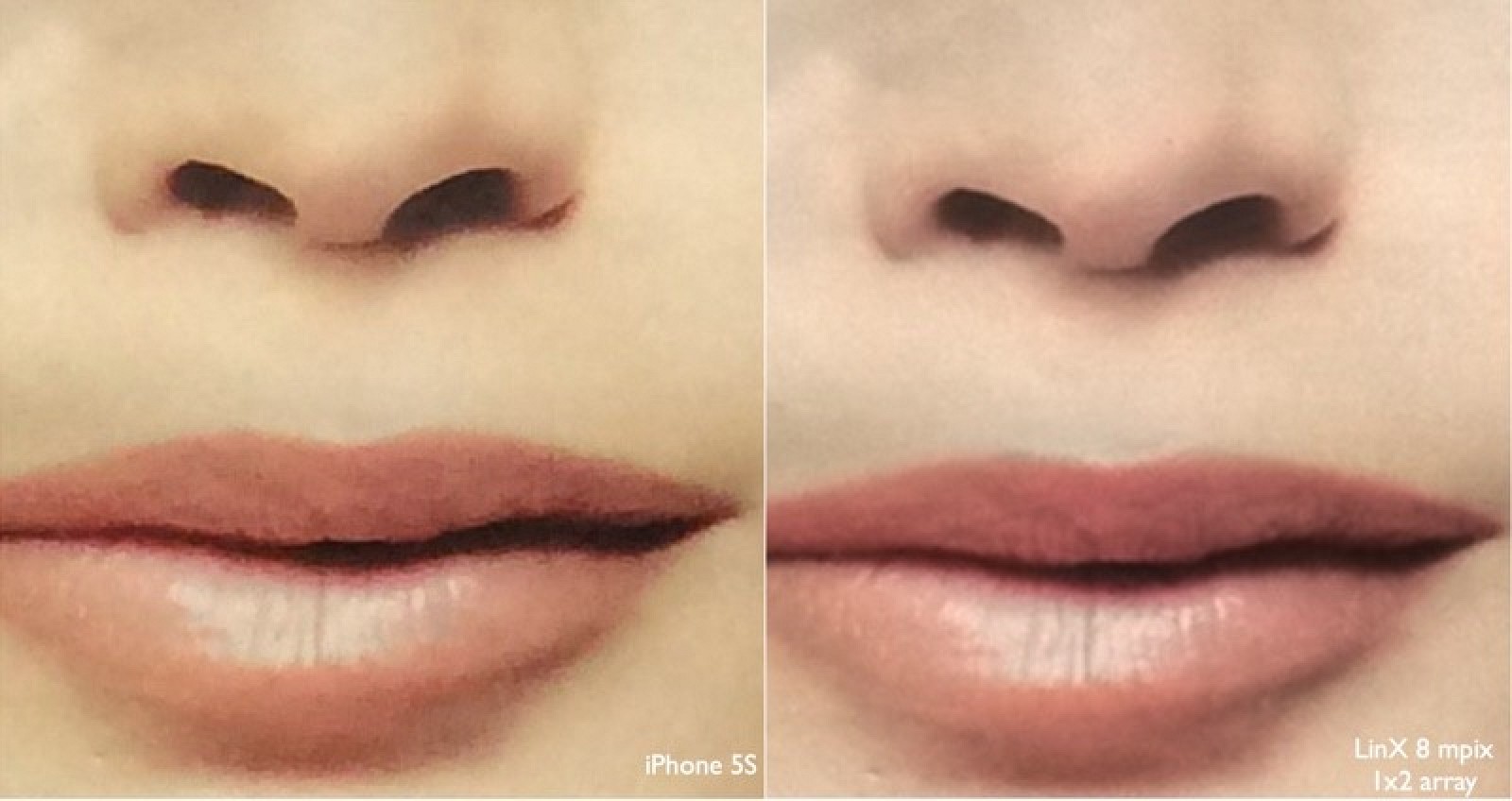
An
example of LinX's noise reduction technology. Far more detail is
preserved in the LinX image on the right compared to the iPhone 5 image
on the left.
There's a possibility that a dual-lens system like the one LinX created could be used for depth mapping, allowing users to do things like take 3D scans of real world items or use depth information to refocus an image. For additional information on what LinX technology could mean for the iPhone 7, make sure to check out our in-depth LinX post.
Implementing LinX's camera system in the iPhone 7 Plus would potentially allow Apple to cut down on the size of the camera module, doing away with the protruding rear camera lens.
An example of how a dual-lens camera could potentially improve photos taken with the iPhone 7 Plus can be seen in the below video demonstration of similar technology from Corephotonics. Corephotonics' dual-lens system uses a wide-angle lens and a lens capable of 5X optical zoom and aggregates data from both to get a better picture.
We at MacRumors have created a video mockup that outlines what a dual-camera interface could look like in the Camera app on the iPhone, based on a recent Apple patent. In the patent, Apple outlines a split-screen interface with one side displaying the standard view from a wide-angle camera and another side displaying a zoomed-in view from an additional lens with a longer focal length. Pictures and video could be captured with both views simultaneously.
As for the camera in the iPhone 7 and the rumored single-lens iPhone 7 Plus, there's no word on what improvements may be introduced. If a version of the iPhone 7 Plus is set to see major gains in image quality, it stands to reason the iPhone 7 and/or the standard-lens iPhone 7 Plus will also see significant improvement, even if it is implemented outside of a dual-lens system.
According to reliable KGI Securities analyst Ming-Chi Kuo, Apple may be planning to introduce two versions of the iPhone 7 Plus -- one that includes a single-lens camera like the iPhone 7 and one that includes a dual-lens camera system. This would be an unusual move for Apple because it would splinter the iPhone lineup, and it should be noted that the rumor has not yet been confirmed by a second source.
It is possible that Apple is testing different iPhone 7 Plus prototypes, leading to rumors of two planned iPhone 7 Plus devices. Rumors have suggested Apple is testing and considering multiple dual-lens systems from several camera makers in Japan, China, and Taiwan, and suppliers are gearing up to begin producing components for the lenses.
There's also a questionable rumor sourced from Chinese site MyDrivers suggesting the iPhone 7 Plus with the dual-lens camera system could actually be dubbed the "iPhone Pro" to set it apart from the iPhone 7 and the iPhone 7 Plus with a standard single-lens camera. This rumor should be viewed with some skepticism until confirmed.
Dual-Lens Camera Details
Apple is rumored to be working on at least one version of the iPhone 7 Plus that includes a a 12-megapixel dual-lens camera system that takes advantage of technology Apple acquired through the purchase of Israeli camera company LinX Imaging last year. Image quality in the iPhone 7 Plus could be greatly improved with the introduction of a dual-lens system, narrowing the gap between photos taken with the iPhone and those taken with a more robust DSLR cameras.
LinX dual-lens technology offers several potential benefits for the iPhone 7 Plus, with the rumor specifically pointing towards 2-3x optical zoom capabilities, perhaps implemented through the use of two lenses with different focal lengths. With a dual-lens camera system, images captured are clearer and brighter with less noise and truer color, allowing for pictures that include more detail, especially in low light conditions.

There's a possibility that a dual-lens system like the one LinX created could be used for depth mapping, allowing users to do things like take 3D scans of real world items or use depth information to refocus an image. For additional information on what LinX technology could mean for the iPhone 7, make sure to check out our in-depth LinX post.
Implementing LinX's camera system in the iPhone 7 Plus would potentially allow Apple to cut down on the size of the camera module, doing away with the protruding rear camera lens.
An example of how a dual-lens camera could potentially improve photos taken with the iPhone 7 Plus can be seen in the below video demonstration of similar technology from Corephotonics. Corephotonics' dual-lens system uses a wide-angle lens and a lens capable of 5X optical zoom and aggregates data from both to get a better picture.
We at MacRumors have created a video mockup that outlines what a dual-camera interface could look like in the Camera app on the iPhone, based on a recent Apple patent. In the patent, Apple outlines a split-screen interface with one side displaying the standard view from a wide-angle camera and another side displaying a zoomed-in view from an additional lens with a longer focal length. Pictures and video could be captured with both views simultaneously.
As for the camera in the iPhone 7 and the rumored single-lens iPhone 7 Plus, there's no word on what improvements may be introduced. If a version of the iPhone 7 Plus is set to see major gains in image quality, it stands to reason the iPhone 7 and/or the standard-lens iPhone 7 Plus will also see significant improvement, even if it is implemented outside of a dual-lens system.
RAM
According to another prediction from KGI Securities analyst Ming-Chi Kuo, the iPhone 7 and the iPhone 7 Plus may have differing amounts of RAM. The smaller 4.7-inch iPhone 7 may ship with 2GB of RAM, while the larger 5.5-inch iPhone 7 Plus may ship with 3GB RAM.Storage Space
Storage space may also be a differentiating factor between the iPhone 7 and the iPhone 7 Plus. An unconfirmed rumor suggests the larger iPhone 7 Plus could include a high-end 256GB storage option that would not be available with the iPhone 7. 256GB is a capacity that is not offered in any of Apple's current iOS devices, so it is questionable as to whether Apple would introduce such a high-capacity iPhone, but a 256GB SanDisk flash storage chip possibly appropriate for use in an iPhone has been spotted. The rumor did not include a mention of other storage tiers that would be available for the two devices.Wireless Charging
With the Lightning port being used for music playback, there will be
no way to charge the iPhone 7 while headphones are plugged in, which has
sparked some speculation about wireless charging. According to one
rumor, Apple is exploring wireless charging technology that could potentially be included in the iPhone 7.
While Apple is said to be looking into wireless charging for the iPhone 7, there is no guarantee the feature will make it into the finished product. It is also not clear what method Apple would use to implement wireless charging.
While Apple is said to be looking into wireless charging for the iPhone 7, there is no guarantee the feature will make it into the finished product. It is also not clear what method Apple would use to implement wireless charging.


















